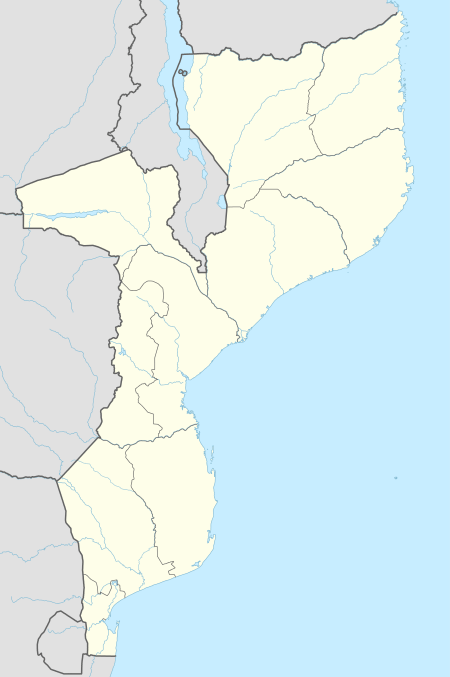Operation Dingo
| Operation Dingo | |||||||
|---|---|---|---|---|---|---|---|
| Part of the Rhodesian Bush War | |||||||
 Chimoio Tembue Operation Dingo (Mozambique) | |||||||
| |||||||
| Belligerents | |||||||
|
|
| ||||||
| Commanders and leaders | |||||||
|
|
| ||||||
| Units involved | |||||||
|
| Unknown | ||||||
| Strength | |||||||
|
200 soldiers 6 Canberra light bombers 10 Hunter fighter-bombers 6 Vampire fighter-bombers 10 Alouette III helicopters (K-Car with 20mm cannon) 11 Alouette III G-Car (one as command helicopter) | 10,000 guerrillas + ZANLA political/civil elements | ||||||
| Casualties and losses | |||||||
|
2 killed 8 wounded 1 Vampire crashed[1] Total: 10[2] 1 fighter-bomber crashed |
3,000 killed 5,000 wounded Total: 8,000[2] | ||||||
Operation Dingo, also known as the Raid on Chimoio and Tembué, was a major raid conducted by the Rhodesian Security Forces against the Zimbabwe African National Liberation Army (ZANLA) headquarters of Robert Mugabe at Chimoio and a smaller camp at Tembue in Mozambique from 23–25 November 1977. More than 3,000 ZANLA fighters were reported as killed and 5,000 wounded while only two government troops died and six were wounded.[2]
The Operation
96 SAS and 48 Rhodesian Light Infantry (RLI) paratroopers and an additional 40 helicopter-borne RLI troops attacked the camps at 07h45 in the morning to exploit the concentration of forces on the parade ground for morning parade, directly after a strike by the Rhodesian Air Force's aging Canberra and Hunter strike aircraft. To strike as many ground targets as possible, six mothballed Vampire jets dating from the 1940s were brought back into use for the operation.
A Douglas DC-8 airliner was flown over the Chimoio camps 10 minutes before the airstrike as part of a deception plan: the assembled ZANLA forces assumed a second false alarm and not disperse or try to take cover when the Rhodesian Air Force aircraft participating in the actual airstrike subsequently approached.[3] In their first pass, four Canberra bombers dropped 1200 Alpha bombs (Rhodesian-designed anti-personnel cluster bombs) over an area 1.1 kilometres (0.68 mi) long and 500 metres (1,600 ft) wide.[4]
Following the initial air strikes by the Canberras, Hunters and Vampire FB9's, ten Alouette III helicopter gunships ("K-Cars" in the attackers' terminology) engaged opportunity targets in allocated areas that together inflicted the majority of the casualties, while two Vampire T11's flew top cover. The paratroopers and heliborne troops were deployed on three sides of the objective into various stop groups and sweep lines,[5] and were also effective in killing large numbers of fleeing ZANLA cadres. Nevertheless, the small size of the ground force and the lack of a complete envelopment allowed a number of fleeing ZANLA cadres to escape. Two important targets of the attack, ZANLA commanders Josiah Tongogara and Rex Nhongo escaped.
A "stay-behind" force of SAS remained in ambush positions around the area overnight to wait for any ZANLA who might return; these SAS were then extracted by helicopter in the morning.[6] The Rhodesian force withdrew in good order having suffered one SAS member being shot and killed at Chimoio, and a Vampire pilot, Flt Lt Phillip Haigh, was killed trying to crash land his jet in a field after his aircraft was damaged by ground fire while overflying Vanduzi Crossroads (18°57′14.5″S 33°15′49″E / 18.954028°S 33.26361°E). The pilot chose to attempt a forced landing rather than execute the dangerous act of bailing out of the Vampire which was not fitted with an ejection seat.[7]
Several tons of equipment was captured. The captured equipment was ether destroyed where it was found or it was taken back to Rhodesia.
Aftermath
A similar attack was repeated two days later at Tembue. (14°47′33″S 32°50′10″E / 14.79250°S 32.83611°E). On that occasion, the morning parade had been cancelled, making the cluster bomb strike on the parade ground assembly ineffective. Though there was a Mozambique Liberation Front base nearby they did not interfere in the Rhodesian force's activities.
A new base was later built in the Chimoio area. The Rhodesians attacked it in 1978 under Operation Snoopy. Operation Dingo was to be followed by a further thirty cross-border raids before the end of the war.
See also
References
- ↑ JRT Wood. "Rhodesia: Roll of Honour". Retrieved 2007-09-27.
- 1 2 3 Winds of Destruction Pg. 446
- ↑ JRT Wood. "Helicopter Warfare in Rhodesia: 1962–1980". Retrieved 2007-09-27.
- ↑ Petter-Bowyer, Winds of Destruction pp. 382 and 439
- ↑ Cox, Chris, Fireforce
- ↑ Petter-Bowyer p
- ↑ JRT Wood. "Rhodesia: Roll of Honour". Retrieved 2007-09-27.
Bibliography
- Petter-Bowyer, P. J. H. (2003). Winds of Destruction: the Autobiography of a Rhodesian Combat Pilot. Trafford Publishing. ISBN 1-4120-1204-X.
- Geldenhuys, Preller (13 July 2007). Rhodesian Air Force Operations with Air Strike Log. Durban, South Africa: Just Done Productions Publishing. ISBN 978-1-920169-61-9.